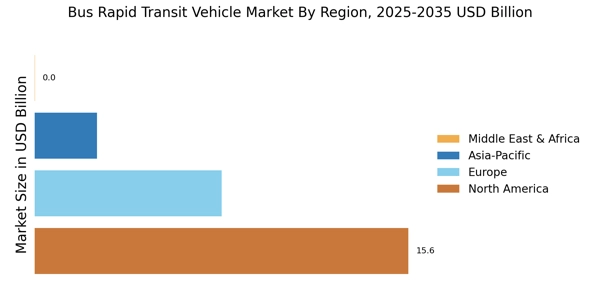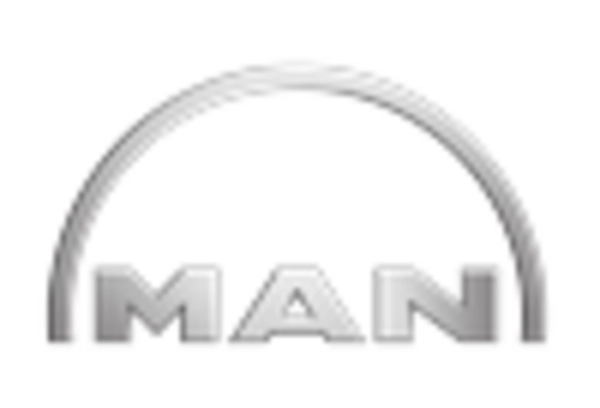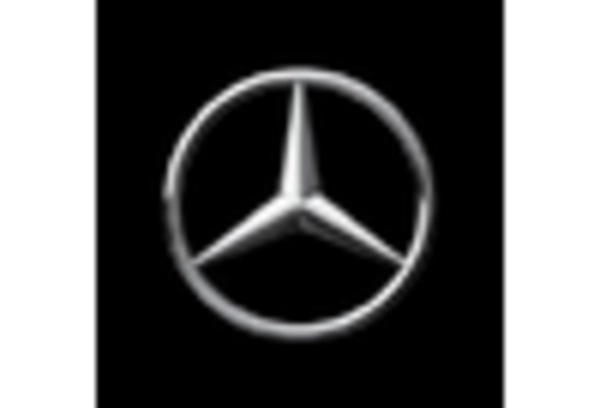Rising Urbanization
Rising urbanization is a critical driver of the Bus Rapid Transit Vehicle Market. As urban populations continue to swell, cities are grappling with increased traffic congestion and pollution. This scenario necessitates the development of efficient public transport systems, with BRT emerging as a viable solution. Current estimates indicate that urban areas are expected to house over 68% of the world population by 2050, intensifying the demand for effective transit solutions. BRT systems, characterized by their dedicated lanes and high capacity, can transport large numbers of passengers quickly and efficiently. Consequently, the Bus Rapid Transit Vehicle Market is poised for growth as municipalities invest in BRT infrastructure to accommodate the needs of their expanding populations.
Environmental Regulations
Environmental regulations are increasingly shaping the Bus Rapid Transit Vehicle Market. Governments worldwide are implementing stringent policies aimed at reducing greenhouse gas emissions and promoting sustainable transportation. These regulations often mandate the adoption of cleaner technologies in public transport, thereby driving the demand for eco-friendly BRT vehicles. For instance, many cities are now required to transition to low-emission or zero-emission buses, which has led to a surge in the development of electric and hybrid BRT vehicles. This shift not only aligns with global sustainability goals but also enhances the attractiveness of BRT systems to environmentally conscious consumers. As a result, the Bus Rapid Transit Vehicle Market is likely to expand as manufacturers innovate to meet these regulatory demands.
Technological Advancements
Technological advancements are significantly influencing the Bus Rapid Transit Vehicle Market. Innovations in vehicle design, propulsion systems, and smart technologies are enhancing the efficiency and appeal of BRT systems. For example, the integration of electric and hybrid buses is becoming increasingly prevalent, driven by the need for sustainable transport solutions. Data suggests that the adoption of electric BRT vehicles could reduce operational costs by up to 30%, making them an attractive option for transit authorities. Furthermore, the implementation of real-time tracking and communication systems is improving service reliability and passenger experience. As these technologies continue to evolve, they are expected to reshape the Bus Rapid Transit Vehicle Market, making it more competitive and responsive to urban mobility needs.
Government Initiatives and Funding
Government initiatives and funding play a pivotal role in the Bus Rapid Transit Vehicle Market. Various governments are increasingly recognizing the need for efficient public transportation systems to alleviate urban congestion and reduce carbon emissions. As a result, many countries are allocating substantial budgets to develop and enhance Bus Rapid Transit (BRT) systems. For instance, recent reports indicate that investments in BRT infrastructure have surged, with some regions earmarking over 20 billion dollars for expansion projects. This financial backing not only facilitates the procurement of advanced BRT vehicles but also supports the establishment of dedicated lanes and stations, thereby enhancing the overall efficiency of public transport. Consequently, the Bus Rapid Transit Vehicle Market is likely to experience robust growth as these initiatives materialize.
Public Awareness and Demand for Efficient Transport
Public awareness and demand for efficient transport solutions are crucial factors influencing the Bus Rapid Transit Vehicle Market. As urban dwellers become more conscious of the benefits of public transportation, there is a growing expectation for reliable and efficient services. Surveys indicate that a significant portion of the population prefers public transport options that are fast, affordable, and environmentally friendly. This shift in consumer preference is prompting transit authorities to invest in BRT systems, which are designed to meet these demands. The increasing popularity of BRT systems, characterized by their speed and efficiency, is likely to drive the Bus Rapid Transit Vehicle Market forward as cities strive to enhance their public transport offerings.


















Leave a Comment